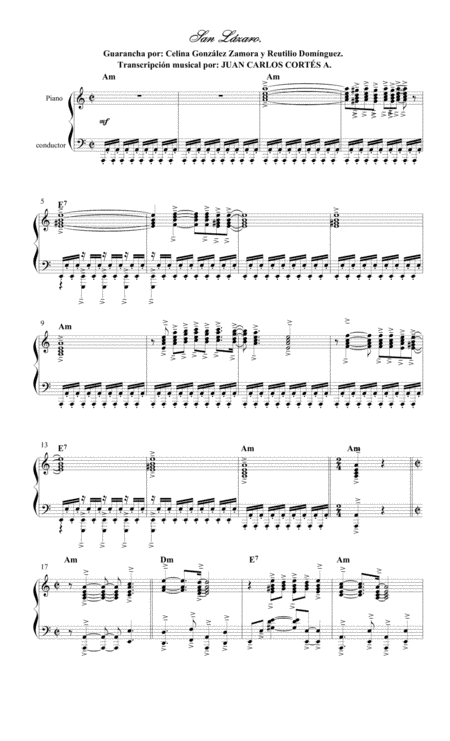Piano Solo - Digital Download SKU: A0.958724 Composed by Celina González Zamora y Reutilio DomÃnguez Terrero. Arranged by Juan Carlos Cortés A. Concert,Latin,Standards,Traditional. Score. 5 pages. Juan Carlos Cortés Aguirre #6116393. Published by Juan Carlos Cortés Aguirre (A0.958724). Transcripción para piano solo por:JUAN CARLOS CORTÉS A.De la Guaracha San Lázaro compuesta e interpretada por Celina González Zamora (Nueva Luisa, Jovellanos, Matanzas 16 de marzo de 1928 - La Habana 4 de febrero de 2015) y Reutilio DomÃnguez Terrero (Guantánamo 1921 - 1971)Celina y Reutilio rompen con una vieja separación que existÃa entre la música guajira y la música afro, establecen una nueva fusión donde la métrica, o sea, la décima hispánica y el estilo del punto guajiro, se mantienen, pero la letra se refiere a temas del patrimonio cultural del continente negro. La acogida del público se debe no solo a lo novedoso de la tonada sino quizá a varias otras razones. El dúo combinaba la restallante voz de Celina, como se la ha llamado, con el sonido producido por Reutilio, que parecÃa provenir no de una sino de dos o más guitarras. Vale la pena ahondar un poco sobre esto último. En los tradicionales dúos y trÃos de punto cubano y son montuno generalmente se utilizaban dos guitarras, o una guitarra y otro instrumento de cuerdas. Un músico tocaba la llamada guitarra prima, o sea, los tonos agudos, como es el caso de Miguel Matamoros en su trÃo, mientras que un segundo guitarrista ‘bordoneaba’, es decir, marcaba los tonos bajos, como hacÃa Rafael Cueto con sus famosos ‘tumbaos’ en el TrÃo Matamoros. Reutilio DomÃnguez reunÃa una desarrollada técnica, asà como dedos, muñeca y antebrazo supremamente flexibles que le permitÃan tocar la prima y bordonear al mismo tiempo, de manera que el dúo de Celina y Reutilio sonaba como un trÃo.VÃdeo You Tube Celina y Reutilio:https://www.youtube.com/watch?v=-mS0nW8HTzkTexto:San LázaroGuarancha por: Celina González Zamora y Reutilio DomÃnguez Terrero.Introducción:Babalú ayé mi mozo,babalú ayé ecua.Que Babalú ayé mi mozo,babalú aye ecua.Guaracha:Eh,eh, ecua,babalú ayé, ekua,Ecua, papa ecua,babalú ayé, ecua,Ecua, viejo ecua,babalú ayé, ecua,Ecua, papa ecua,babalú ayé, ecua,Que yo va subà y usted va bajá,con los zapato de chango te.De Chango te,mi chango ta,chango taito y obatalá.Ay, Babalú ayé,padre mÃo San Lazaro.Ay, padre mio aeh,padre mÃo San Lázaro.Ayudanos en nombre de Dios,padre mÃo San Lázaro.Ay, pero que sea de corazón,padre mÃo San Lázaro.Piano: Recitado:Ekua babalu aye,sacuapa asoñi,asujana papá,Eh...Son troni carará,Afilapa, osuo no pequeña toto.Piano: Guaracha:Chango te,de chango ta,chango taito y obatalá.Ay, babalú ayé,padre mÃo San Lázaro.Que yo quiero ser y un senserico,padre mÃo San Lázaro...Ay, pero que sea de corazónpadre mÃo San Lázaro...Que yo va subà y usted va bajá,con los zapato de chango te.De Chango te,de chango ta,chango taito de obatalá.
